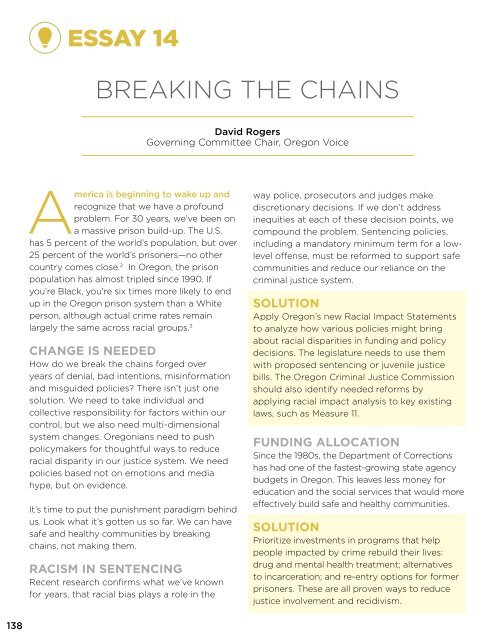State-Of-Black-Oregon-2015
State-Of-Black-Oregon-2015
State-Of-Black-Oregon-2015
Create successful ePaper yourself
Turn your PDF publications into a flip-book with our unique Google optimized e-Paper software.
ESSAY 14BREAKING THE CHAINSDavid RogersGoverning Committee Chair, <strong>Oregon</strong> VoiceAmerica is beginning to wake up andrecognize that we have a profoundproblem. For 30 years, we’ve been ona massive prison build-up. The U.S.has 5 percent of the world’s population, but over25 percent of the world’s prisoners—no othercountry comes close. 2 In <strong>Oregon</strong>, the prisonpopulation has almost tripled since 1990. Ifyou’re <strong>Black</strong>, you’re six times more likely to endup in the <strong>Oregon</strong> prison system than a Whiteperson, although actual crime rates remainlargely the same across racial groups. 3CHANGE IS NEEDEDHow do we break the chains forged overyears of denial, bad intentions, misinformationand misguided policies? There isn’t just onesolution. We need to take individual andcollective responsibility for factors within ourcontrol, but we also need multi-dimensionalsystem changes. <strong>Oregon</strong>ians need to pushpolicymakers for thoughtful ways to reduceracial disparity in our justice system. We needpolicies based not on emotions and mediahype, but on evidence.It’s time to put the punishment paradigm behindus. Look what it’s gotten us so far. We can havesafe and healthy communities by breakingchains, not making them.RACISM IN SENTENCINGRecent research confirms what we’ve knownfor years, that racial bias plays a role in theway police, prosecutors and judges makediscretionary decisions. If we don’t addressinequities at each of these decision points, wecompound the problem. Sentencing policies,including a mandatory minimum term for a lowleveloffense, must be reformed to support safecommunities and reduce our reliance on thecriminal justice system.SOLUTIONApply <strong>Oregon</strong>’s new Racial Impact <strong>State</strong>mentsto analyze how various policies might bringabout racial disparities in funding and policydecisions. The legislature needs to use themwith proposed sentencing or juvenile justicebills. The <strong>Oregon</strong> Criminal Justice Commissionshould also identify needed reforms byapplying racial impact analysis to key existinglaws, such as Measure 11.FUNDING ALLOCATIONSince the 1980s, the Department of Correctionshas had one of the fastest-growing state agencybudgets in <strong>Oregon</strong>. This leaves less money foreducation and the social services that would moreeffectively build safe and healthy communities.SOLUTIONPrioritize investments in programs that helppeople impacted by crime rebuild their lives:drug and mental health treatment; alternativesto incarceration; and re-entry options for formerprisoners. These are all proven ways to reducejustice involvement and recidivism.138


